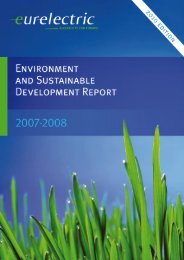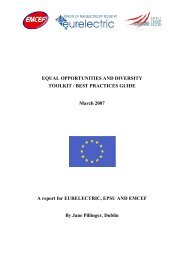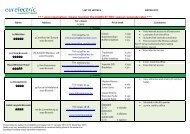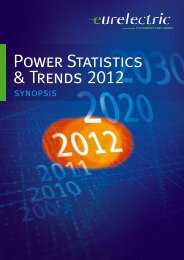Power Statistics - 2010 Edition - Full Report - Eurelectric
Power Statistics - 2010 Edition - Full Report - Eurelectric
Power Statistics - 2010 Edition - Full Report - Eurelectric
Create successful ePaper yourself
Turn your PDF publications into a flip-book with our unique Google optimized e-Paper software.
Demand 2.3 Comments<br />
66 <strong>Power</strong> <strong>Statistics</strong> – <strong>2010</strong> <strong>Edition</strong> – <strong>Full</strong> <strong>Report</strong><br />
LUXEMBOURG (lu)<br />
Overall demand of electricity in Luxembourg amounted to 6,703 GWh in 2008 decrease by 1.4%<br />
compared to the previous year. This decrease is due to the impact to industry of the international<br />
financial crisis.<br />
LATVIA (lv)<br />
In 2008, GDP growth was -4.6% and that stimulated the decrease of electricity consumption by 1.5%.<br />
There is significant in industry sector (-10%). Electricity consumption per capita in Latvia is two times<br />
less than EU-27 average.<br />
POLAND (pl)<br />
Peak power demand usually appears in December or in January around 5 p.m. Its’ value to some extent<br />
depends on the outside air temperature. The total electricity consumption in 2009 according to Energy<br />
Market Agency, amounted to 138.7 TWh. Decrease in total energy consumption compared to the year<br />
2008 was ca. 4.0%.<br />
In the year 2009 the maximum demand for power from the national power grid during the year occurred<br />
in December, and amounted to 24,594 MW. Assumed demand for electric energy and peak capacity<br />
refers to standardised years with average temperature.<br />
For Poland, the electricity consumption projections for the time period <strong>2010</strong>-2020 corresponds to<br />
the Development Program for National Transmission System – Expected scenario”. Values for the year<br />
2030 are own estimations of PSE Operator S.A.<br />
PORTUGAL (pt)<br />
Data for Portugal includes islands information (Azores and Madeira), being the total demand referred<br />
to the whole country.<br />
Regarding data for the Mainland Portugal, in 2008:<br />
Electricity demand supplied through the public transmission network reached 50.6 TWh, characterized<br />
by a growth rate over the previous year of 1.1%. The final consumption decreased by 1.2%;<br />
The self-consumption of auto-producers decreased by about 9%, because a higher number of generators,<br />
allowed by specific legislation, deliver their generation to the public network and are being supplied<br />
by the public network;<br />
Ordinary Regime Generation (PRO) plants met around 57% of the total demand while the Special Regime<br />
Generation (PRE) met 22%. The international trade balance corresponds to 18% of total demand;<br />
The peak demand for the connected system occurred in December, with 8,973 MW, 137 MW below the<br />
maximum peak demand recorded in 2007.<br />
Regarding data for the islands Azores and Madeira, in 2008 the electricity consumption represented<br />
3.4% of the total electricity consumption of the whole country.<br />
In table “Annual Energy and Peak Demand”, data for the Connected System does not include:<br />
Demand of Azores and Madeira islands;<br />
Demand of auto-producers for own use.<br />
For medium/long-term planning purposes it is considered that the peak period occurs during 6% of<br />
the time and an annual load factor of approximately 64% is assumed. Peak demand generally occurs in<br />
December or January.

















